Begin in the Middle (Neither Me nor the Bucket)
Alice Gale-Feeny
- Presented by — Seventeen
- Alice Gale-Feeny, Begin in the Middle (Neither Me nor the Bucket), 2021, at Seventeen, part of Performance Exchange 2021. Performed by Manuela Albrecht, Svenja Buehl, Alice Gale-Feeny and Michaela Gerussi. Photo: Manuela Barczewski.
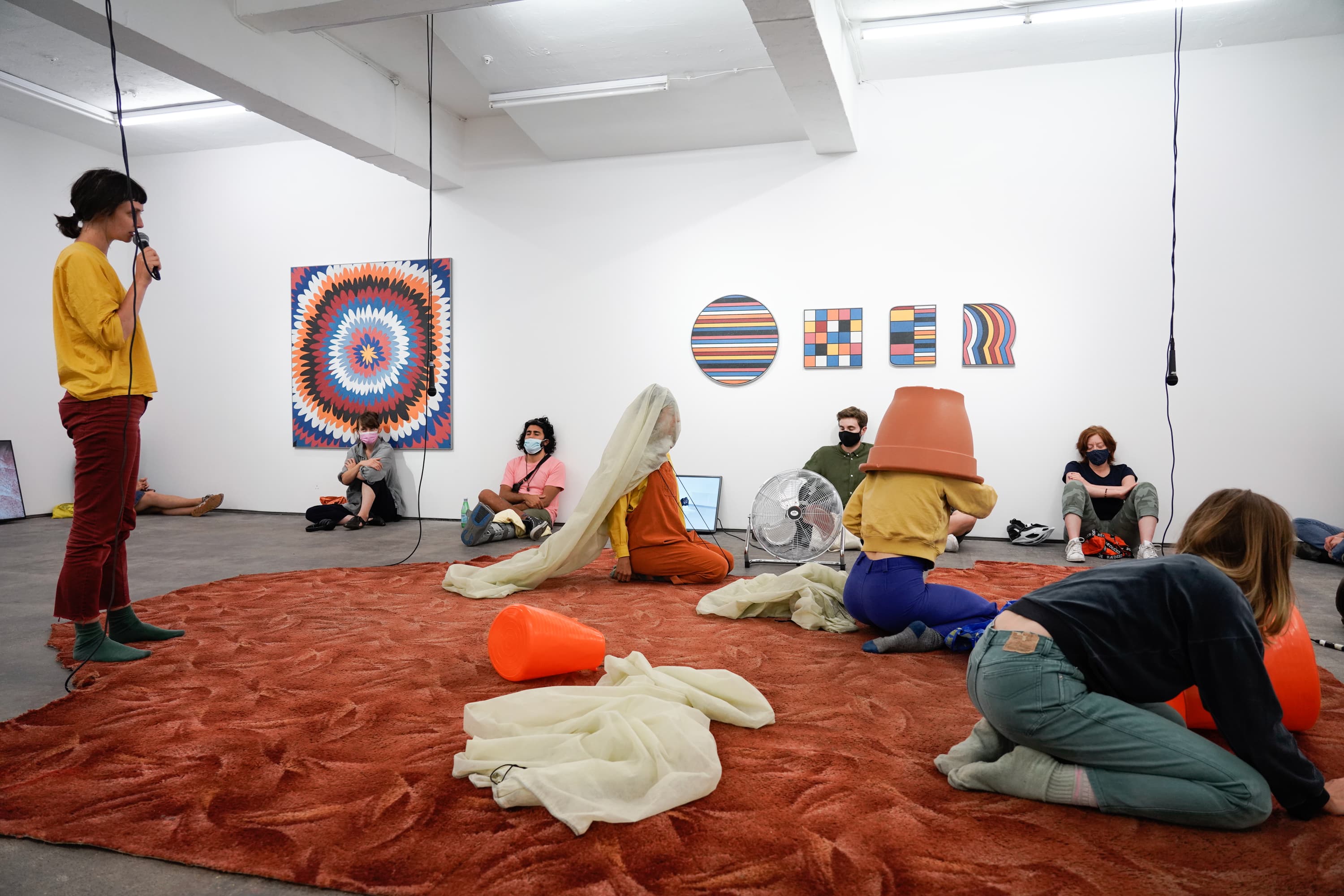
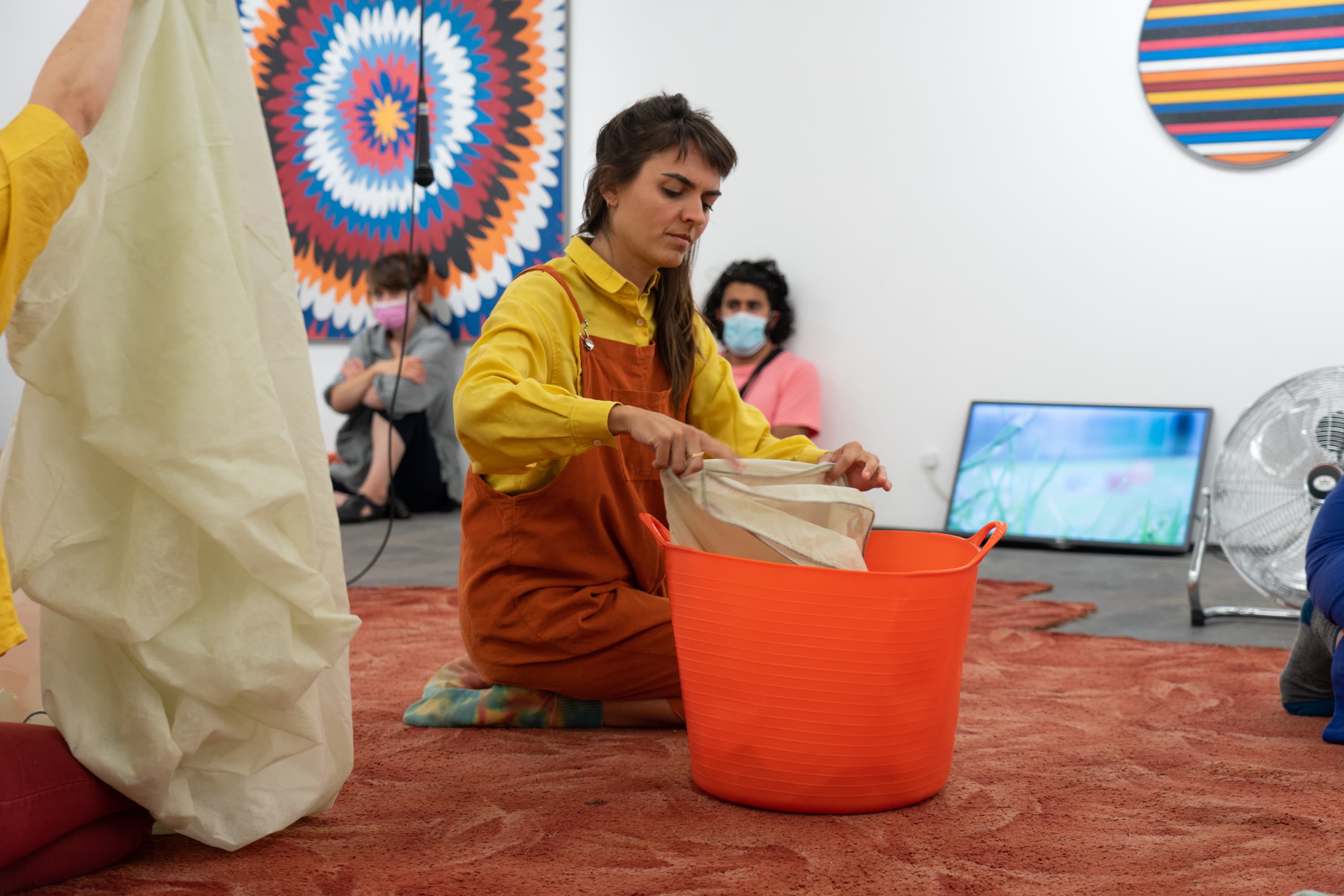
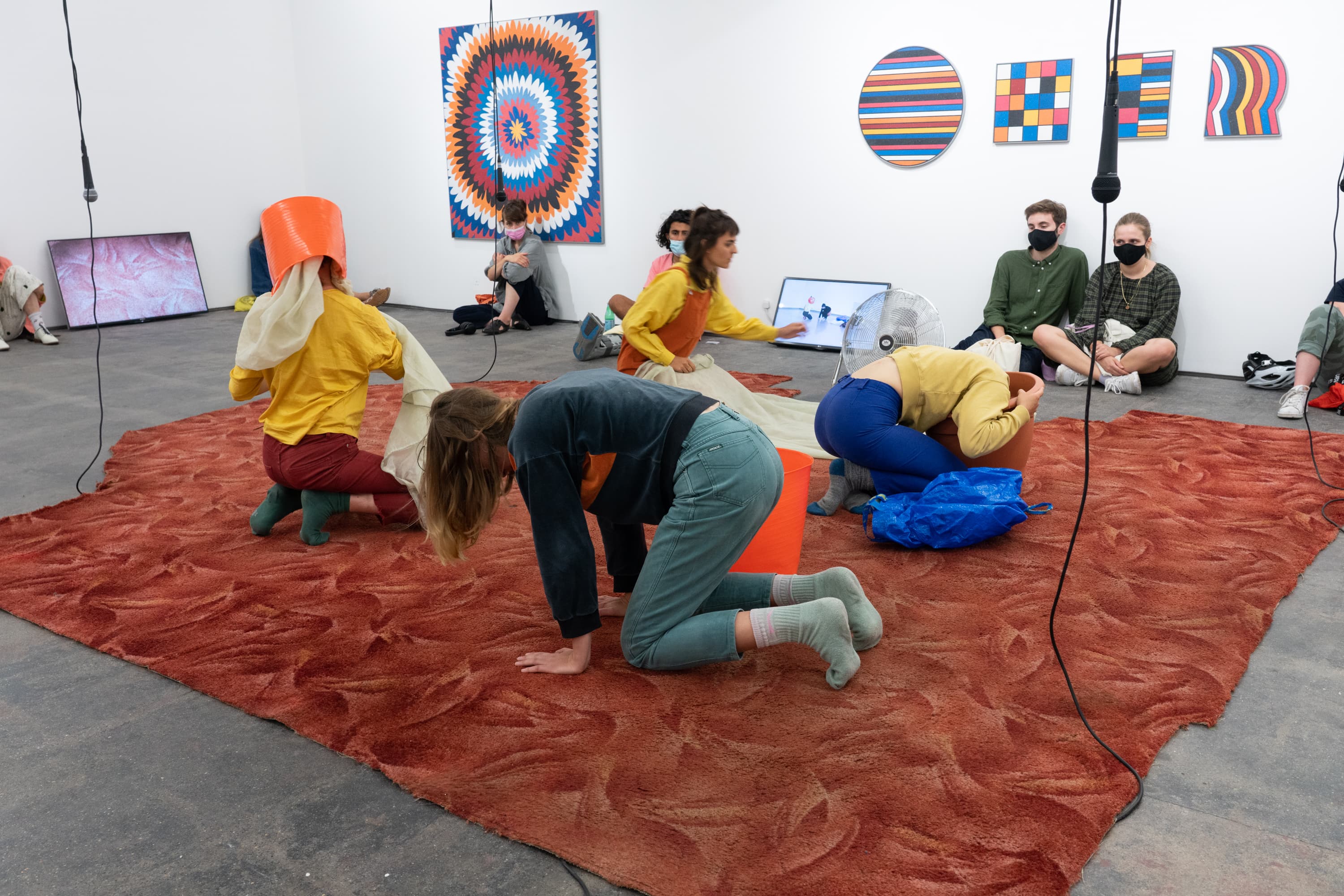
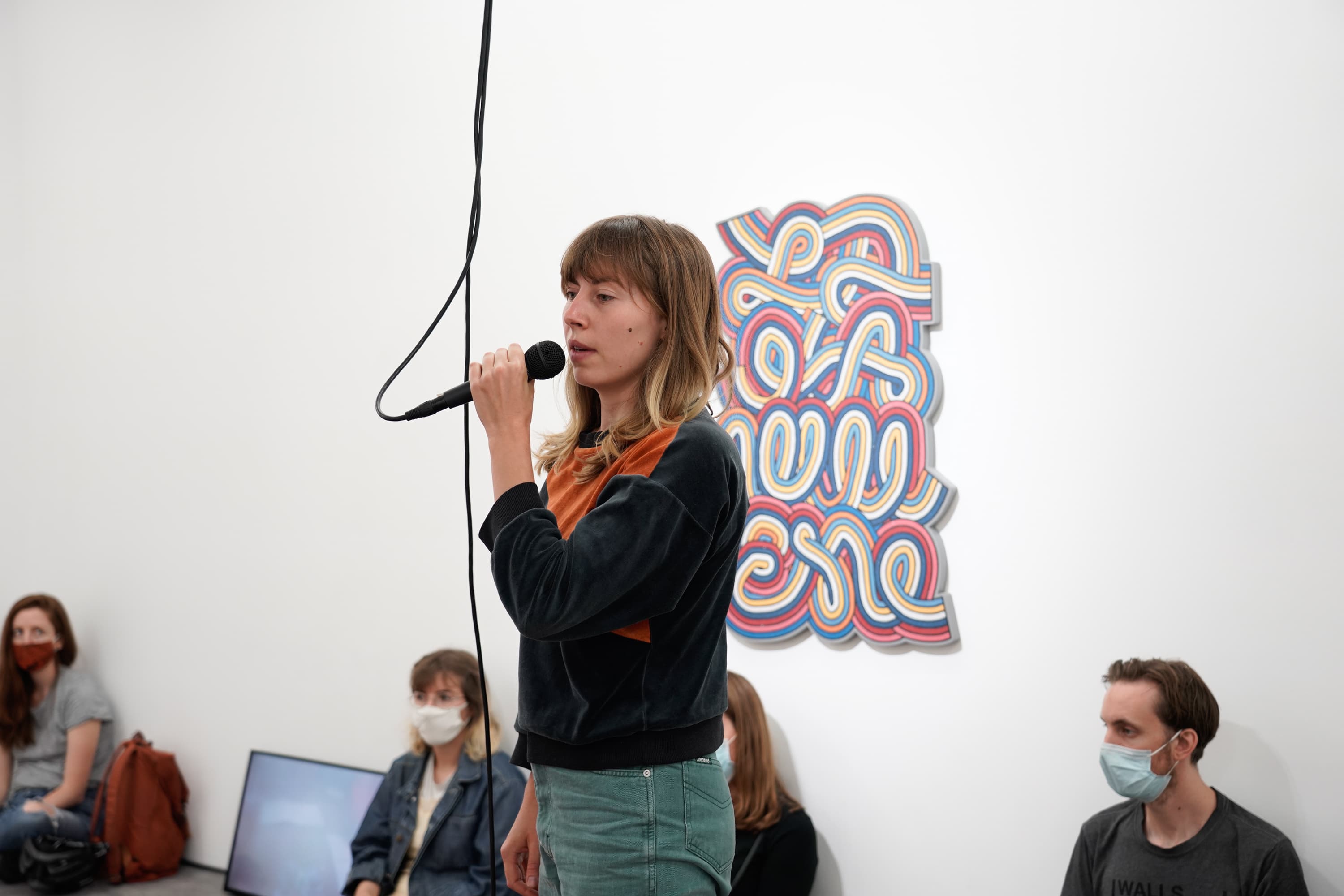
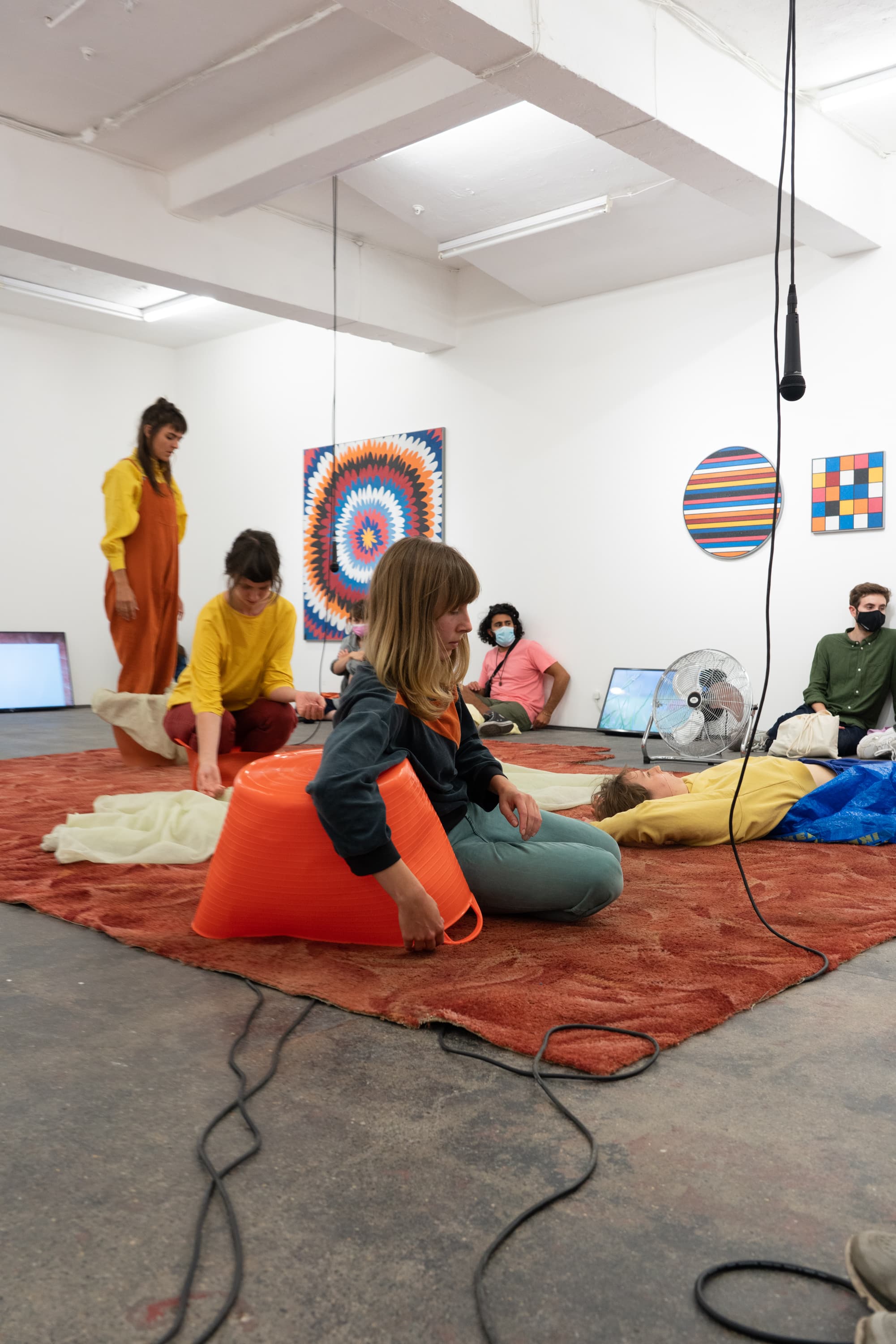
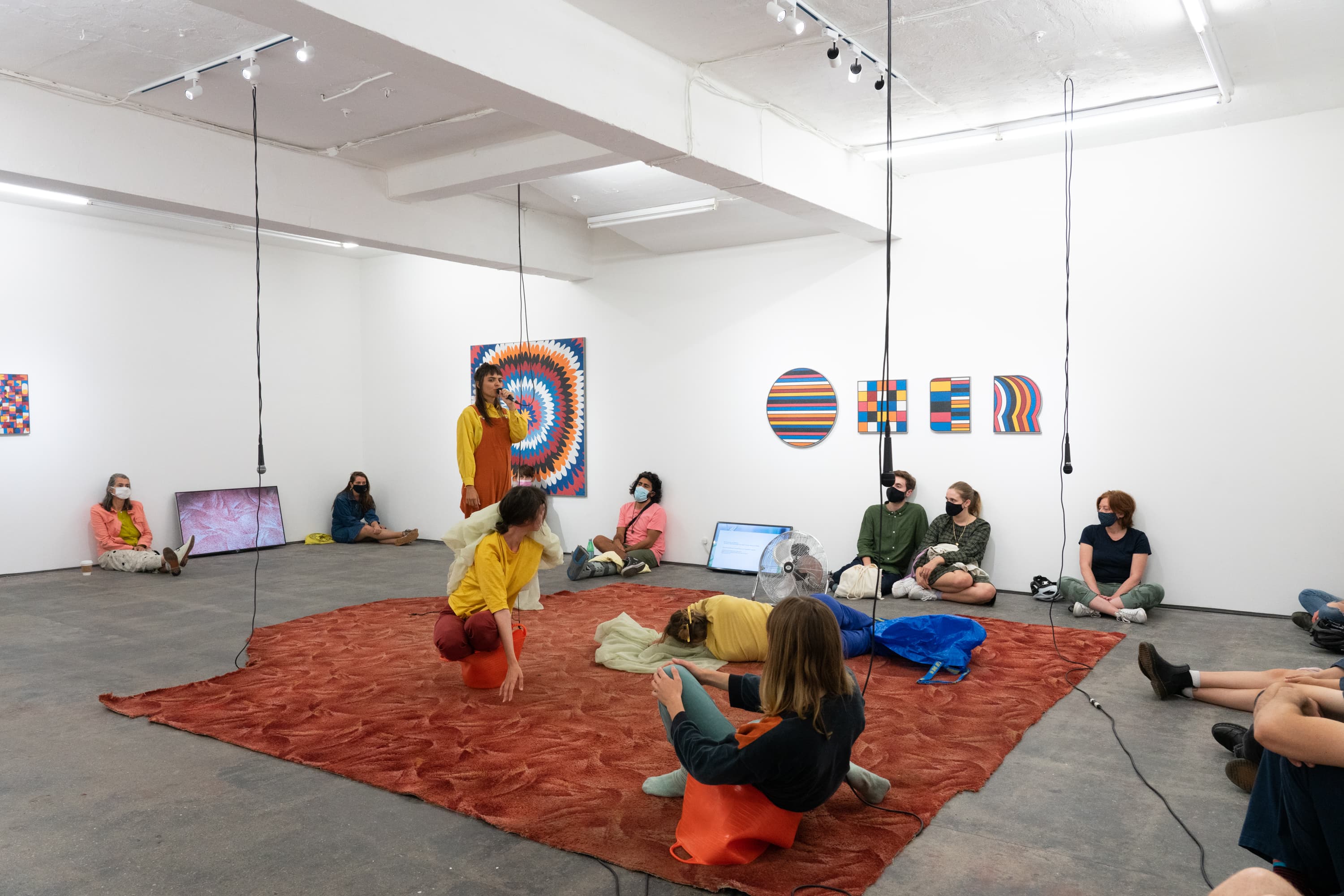
Begin in The Middle (Neither Me, Nor The Bucket) is a performance practice that proposes ways in which we may become-with each other, using a series of physical containers in body-object arrangements, as well as voice and video, to create feedback loops that inform intra-acting solo and group meetings.
The key components of the work are amplified voice (spoken dialogue), pedestrian movement, body-object arrangements and audio/video components. It revolves around a number of texts that are used as axis points. The work currently involves four performers and texts within the performance have been co-written by the artist and the performance collaborators, in this instance Manuela Albrecht, Svenja Buehl and Michaela Gerussi. The texts are spoken and form pre-recorded voiceovers and videos that play at intervals throughout the work.
Conditions of Production
The performers draw from a series of text-based prompts and facilitation instructions provided by the artist. The performers work with the artist in advance of the performance, set texts and plans for movement and to set a framework for improvised material. Use of movement is pedestrian and non-virtuosic. The work prioritises and highlights the somatic experience rather than body design. The performers are present in solos, duets and group formations. Objects are not shared (although performers at times have the same duplicated object), performers have a microphone each to amplify voices.
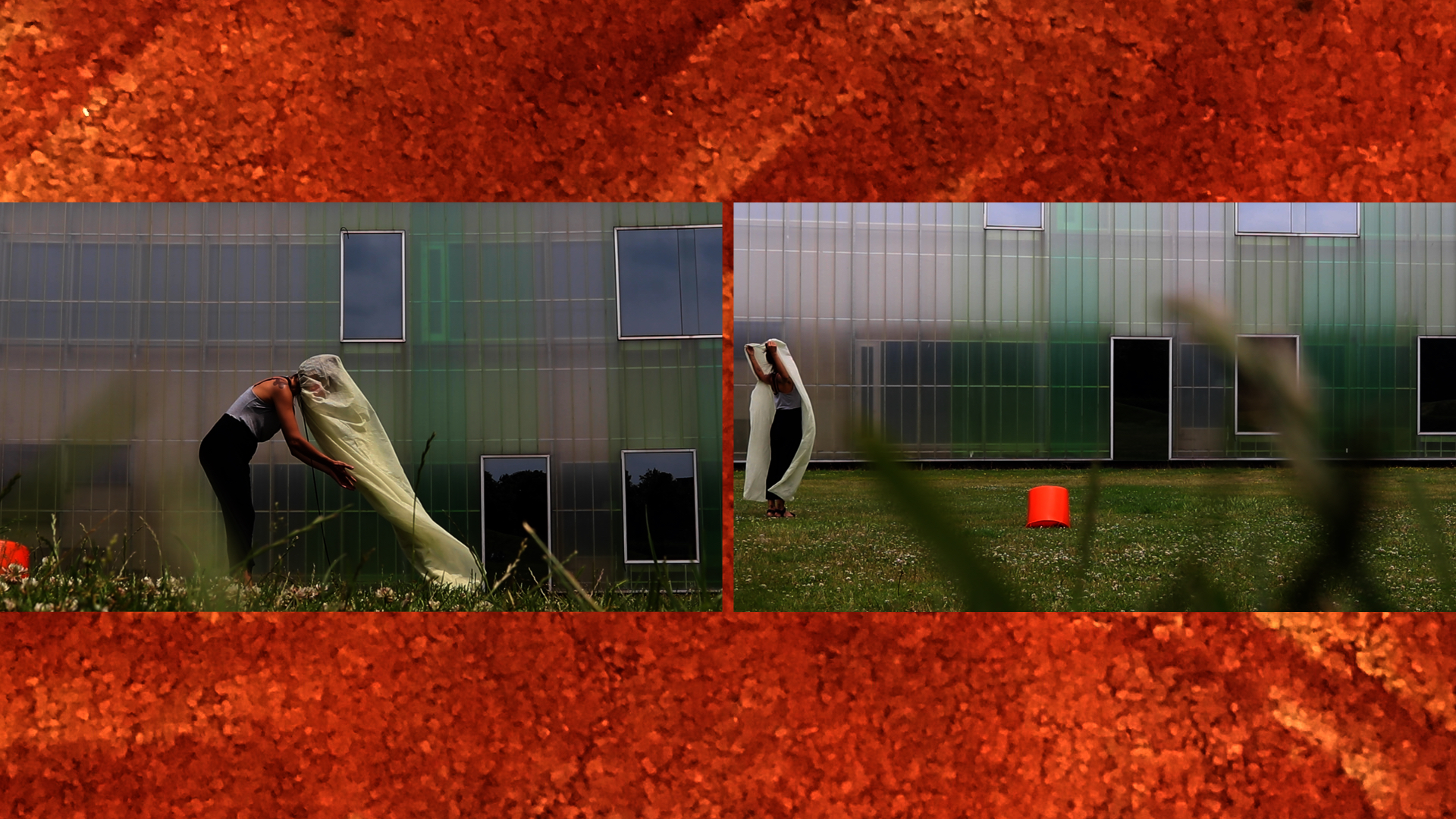
Generating the material
‘Containers’ are used in solo and group rehearsals as a means of thinking through the anatomy of each performer, and how internal space (in anatomical terms) may be mirrored in containers used. The physical surfaces, volumes and flexibility of objects is used as a means of gaining certain touch-based feedback. This is for the purpose of examining the boundary of the body, and testing its porosity. Objects are also considered as ‘useful distractions’ that support the spilling of subjective experience. The abrasive ‘blankness’ of the containers is designed to come into contact with the specificity of the bodies in the work.
The texts are generated over the course of rehearsals. Performers and artist write these texts throughout the rehearsal process and through the practice of working with the objects and others. Writing happens alongside movement; intervals between moving and writing should take place. Texts are typed up and edited throughout, in dialogue with the performers. The texts are shaped into non-linear narratives, and the world of the performance for these bodies involved is teased out, drawing upon imagery arising from the rehearsal process. Texts are recorded as voiceovers and played during rehearsals. The practice continues with this material feeding in. A world is built through the repetition of language, and the emergence of new images and new arrangements. In this way, the methodology is based on the process of ‘recursion’.
Video and audio components of the work
The rehearsals should be filmed and a high quality audio recording made with the idea that this footage supports the resulting final performed work (and appears within it).
The videos used within the performance are from these rehearsals, but should be a tightly edited selection of moments.
They should be an arrangement of frames that aid a sense of build up, of reiteration, of recalibration.
The audio within the videos is designed to create a texture for the performers to move alongside.
The videos should also contain screen recordings of the scripts typed out in real time. These text aid the viewer in digesting the spoken material, as well as conceptually creating shifts in meaning; where text and live action align or feel at odds with one another. The sense of multiplicity should be felt in the combination of text, video and live action and voice.
This videos should be shown on LCD digital monitors of at least 21 inches wide.
The videos plays alongside live components but should have intervals where nothing much is happening, to allow for live components to build momentum and to not be overcrowded.
Editing and filming should take place under the direction of the artist.
Texts
Texts that have been co-written alongside the current performers are a component to the present iteration of the work. These texts are by the artist and Manuela Albrecht, Michaela Gerussi, Svenja Buehl and Alice Gale-Feeny and edited by Alice Gale-Feeny.
Authorship of the performance practice and the performance score including these facilitation instructions and accompanying documents lies with the artist.
The current movement vocabulary is co-devised by Manuela Albrecht, Michaela Gerussi, Svenja Buehl and Alice Gale-Feeny.
The existing texts and movement vocabulary should only be re-performed by Manuela Albrecht, Michaela Gerussi, Svenja Buehl and Alice Gale-Feeny.
The work can be sold as live work to be re-performed in it’s present state by Manuela Albrecht, Michaela Gerussi, Svenja Buehl and Alice Gale-Feeny.
In the event that the current ensemble of performers are not available to enact the work, the movement vocabulary and text as it currently exists should not be re-performed by those not presently in the work, rather new movement material and text should be established through future rehearsals with new performers.
The performance practice will continue to build through its reiteration. The elements that remain as constant are the presence of texts written and memorised by performers, the videos of the practice in its former iterations during rehearsal processes; the use of ‘containers’, and presence of other locations, dependent on the context where the work is rehearsed and staged in the form of audio/ furniture/fixtures.
Performers and rehearsals
The present work requires 10 hours of rehearsal with the original performers or 40 hours of rehearsals with new performers.Ideally this is spread over two weeks to allow for editing time of material, watching rehearsal footage and shaping the work in dialogue with the performers.
The work does not discriminate against age, race or gender and the work does not require able-bodied performers.
The performers should have a dance/movement training (professional or non-professional) to support them to engage with voice and movement improvisation and somatic-based explorations — all essential to the process.
Performers should be based within the vicinity of the location where the work will be presented. An option to begin the rehearsal process online for the first 6 hours is feasible.
Objects
A collection of containers is required, as well as markers of the locations where the work is rehearsed and/or staged. Containers should be collected based on what is readily available to the performers/ within the location. The containers should be varied in their surface texture, their scale and their flexibility. Some objects should be duplicated so that performers at time are working with the same object. Objects will be chosen by the artist, in dialogue with performers.
In this instance, the following objects have been selected to be used (with reasoning):
Two bright orange buckets, one medium and one large, made of flexible plastic (chosen for their eye catching colour and their potential to mirror the pelvis.)
A large brown sturdy plant pot (chosen for its sturdiness, performers can put weight on it without it cracking).
A blue IKEA carrier bag (chosen for its flexibility, and for its ability to create a loud textured sound when moved).
Four large green fleece sheets (chosen for their translucency, their second-skin-like quality, and for the fact they cover the whole body of the present performers in the work).
A carpet removed from the site where the work originated. (Chosen for its ability to speak about another location where the practice originated. An equivalent element such as this could be other interior design fixtures, furniture from studio space, outdoors — the purpose is to create the sense of multiplicity and disorientation within the time/space of the performance).
A standing fan (this is used to re-create the phenomenon of wind).
Performers clothing
Clothing should mirror the formal qualities of the objects, locations, and other elements used either through use of colour to match objects with clothing, or through the cut and shape of the clothing.
Time and structure
The work has a variable duration but should be a minimum of 25 minutes and a maximum of 50 minutes.
As the work deals with a process of ‘recursion’ (where the framework used is recalibrated at a number of points and the ‘model’ that is at first established, is ‘rewritten’ throughout); information within the work builds, and layering happens through repetition and recalibration of material as well as video and text elements that double what is seen live. ‘Material’ is recycled and reframed into new versions and new arrangements.
The performers may not always be on stage, or all at once; they may witness, as certain solos/duets emerge.
Voice
The performers use live spoken voice from texts that are memorised. Improvised speech happens in and around the memorised texts, building on what is said in relation to the present moment of performance. Pre-recorded voice/text within videos acts as a prompt in the space that the performers may speak along with but this is not set.
Rules of Documentation
With every showing of Begin in the Middle (Neither Me nor the Bucket) the exhibiting organisation must:
- Take photographic documentation of each performer as they undertake the performance practice, outside of exhibition times with no audience present
- Take video documentation of the staging as a whole
- Record a copy of performer’s contracts
- Send a copy of this documentation to the artist.
- Send copies of scripts and videos to the artist.
Documentation cannot be exhibited in lieu of a performance. Documentation will provide more information for the next staging of the work. Begin in the Middle (Neither Me nor the Bucket) will therefore change over time and with every reiteration and group of performers, as the structure of the work is built on the emergence of new details and new arrangements that build on pre-existing structures.
Public documentation (such as on a gallery’s website) of Begin in the Middle (Neither Me nor the Bucket) should be in the form of still images rather than video.
Exhibiting organisations can determine if audiences are allowed to take videos of the performance ensuring the performers are aware of the rules and are protected by gallery staff.
Conditions of reselling
Begin in the Middle (Neither Me nor the Bucket) can be resold with the same conditions outlined in this document. Artist requirements regarding the process, exhibition and documentation of the work must be adhered to by all future owners of Begin in the Middle (Neither Me nor the Bucket).
Collectables
-
The collector will be entitled to the following
- A printed copy of the methodology
- The rights to re-stage the methodology in accordance with the guidelines and agreement
- The owner will be credited in all future materials relating to the methodology